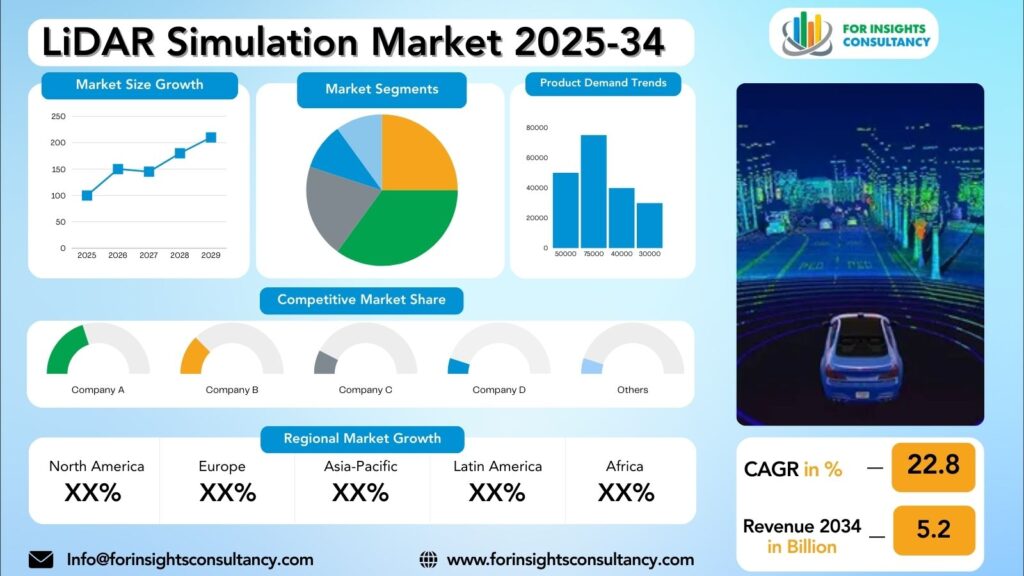
LiDAR Simulation Market Research Report by Application (Autonomous Vehicle (AV), Advanced Driver-Assistance Systems (ADAS), Robotics, Mapping), By Component (Software, Services), by Deployment Type (On-premise, Cloud-based), by End-Use Industry (Automotive, Aerospace & Defense, Construction, Agriculture, Logistics & Transportation), and Region Global Market Analysis and Forecast, 2025-2034
Aug-2025 Formats | PDF | Category: Automotive | Delivery: 24 to 72 Hours
LiDAR Simulation Market is forecast to increase from USD 0.91 Billion in 2025 to USD 5.2 Billion by 2034, at a CAGR of 22.8%.
LiDAR Simulation Market: A Comprehensive Overview and Future Developments
The LiDAR simulation market is a rapidly growing segment of the LiDAR industry, offering advanced software and hardware solutions for creating realistic virtual environments. These simulations enable companies to test and optimize LiDAR systems cost-effectively without the need for physical prototypes. LiDAR simulation allows companies to replicate real-world scenarios, such as weather conditions, terrains, and traffic, to validate and optimize systems before deployment. By using advanced algorithms and models, simulation software can accurately predict sensor performance and validate the safety and reliability of autonomous Cars and other LiDAR applications.
The future of the LiDAR simulation market is promising, with continuous technological advancements and increasing demand for LiDAR solutions across various industries. The integration of artificial intelligence and machine learning algorithms is one key trend shaping the future of the market, enabling simulation software to learn from past data and optimize LiDAR performance in real-time. Cloud-based simulation platforms are expected to streamline simulation workflow and enhance collaboration among industry stakeholders.
LiDAR Simulation Market Dynamics
Growth Drivers
The LiDAR simulation market is driven by technological advancements, increasing demand for simulation software that accurately replicates real-world scenarios. The increasing adoption of LiDAR systems across industries like autonomous vehicles, urban planning, and environmental monitoring has led to a higher demand for accurate and reliable simulation software. Companies that offer high-quality LiDAR simulation solutions can establish themselves as market leaders. The shift towards cost-effective solutions is another driving factor, as companies seek software that is not only accurate and reliable but also affordable.
Offering affordable and efficient LiDAR simulation tools can attract a wider customer base and expand their market share. As LiDAR systems become more widespread, regulatory requirements around data accuracy and simulation testing are becoming more stringent. Companies that meet these standards will have a competitive edge in the market. Collaboration and partnerships between companies in the LiDAR simulation market are also driving growth, as they work together to develop integrated solutions that combine hardware and software capabilities, offering customers a comprehensive LiDAR simulation experience.
Restraints
The LiDAR simulation market holds significant potential for innovation and progress in various industries. Companies can leverage partnerships with research institutions, industry associations, and technology providers to pool resources, share knowledge, and accelerate innovation in LiDAR simulation. This can help address cost constraints, enhance simulation models, and establish industry standards. Investment in R&D is essential for advancing LiDAR simulation technology and overcoming complexity challenges.
Allocating resources to develop advanced algorithms, optimize software performance, and integrate emerging technologies can enhance the realism and accuracy of LiDAR simulations. Providing training programs and educational resources can address the lack of expertise in LiDAR simulation, improving the quality of simulation models, reducing development time, and fostering innovation. By addressing these restraints effectively, industry players can unlock new opportunities and propel the growth of the LiDAR simulation market.
Opportunities
The LiDAR simulation market offers several opportunities, including enhanced accuracy and precision in simulations, cost-effective solutions, and diverse applications across different sectors. Advancements in technology enable LiDAR sensors to capture detailed 3D representations of the environment, providing a significant advantage for industries like autonomous vehicles. The market also offers cost-effective solutions, as businesses can test and validate LiDAR systems in a virtual environment, saving time and resources. The versatility of LiDAR technology allows for applications in topographic mapping, forestry management, infrastructure planning, and security monitoring, expanding market reach and catering to a broader customer base. Innovation is at the heart of the LiDAR simulation market, offering a fertile ground for collaboration among industry players. By joining forces with technology providers, research institutions, and regulatory bodies, businesses can drive innovation and develop groundbreaking solutions that address evolving market needs.
Challenges
The LiDAR simulation market faces several challenges, including a lack of standardization, the complexity of simulation models, and cost and resource constraints. The market is characterized by multiple players offering different simulation tools and technologies, making it difficult for companies to compare and evaluate different solutions effectively. To address this, industry organizations and regulatory bodies need to collaborate to develop common standards and guidelines for LiDAR simulation.
The complexity of simulation models is another challenge, as LiDAR data is highly detailed and requires sophisticated algorithms and computational techniques to accurately simulate real-world scenarios. This can be time-consuming and resource-intensive, making it difficult for companies to scale their capabilities effectively. To overcome this, companies need to invest in innovation and research to develop more efficient and scalable simulation models.
Cost and resource constraints are significant barriers to entry in the LiDAR simulation market, as Developing high-quality simulation tools and technologies requires substantial investment in hardware, software, and skilled personnel. Small and medium-sized enterprises may struggle to compete with larger companies with more extensive resources and capabilities. To address this, companies can explore collaborative partnerships and strategic alliances to pool resources and expertise, reduce costs, accelerate innovation, and expand their reach in the competitive LiDAR simulation market.
LiDAR Simulation Market Top Companies Covered In This Report:
Evaluate The Strategic Positioning And Innovation Pipelines Of Leading Market Companies-From Multinational Enterprises To Disruptive Regional Firms. Understand How Key Players Are Innovating, Expanding, And Capturing Value, And Use Competitive Benchmarks To Plan Your Next Move.
- Siemens
- Vector Informak GmbH (Germany)
- Applied Intuition (US)
- Cognata (Israel)
- dSpace GmbH (Germany)
- IPG Automotive GmbH (Germany)
- Dekra (Germany)
- AVL (Austria)
- Valeo (France)
- RoboSense (China)
- Luminar Technologies (US)
- Hesai Technology (China)
- XenomatiX (Belgium)
- Cepton, Inc. (US)
- Innoviz Technologies (Israel)
- Quanergy Solution, Inc. (US)
LiDAR Simulation Market News
Cognata
In September 2024, Cognata unveiled its DriveMatriX technology, which uses generative AI to create a free perception training dataset. This initiative aims to address the data scarcity problem in the industry by allowing engineers to validate perception models under a variety of challenging weather and lighting conditions.
Siemens
Release Updates: The release of Simcenter Prescan 2503 in early 2025 introduced new features such as an off-the-shelf city and enhanced physics-based camera models, which directly contribute to the high-fidelity simulation needed for LiDAR validation.
dSPACE
At the European Microwave Week (EuMW) in 2024, dSPACE showcased a new solution for testing automotive radar sensors. While specific LiDAR news was less frequent, the company’s focus on reproducible, controlled laboratory testing for ADAS sensors is a key part of the broader sensor simulation market.
Segmented View of the Industry:
The LiDAR Simulation Market Is Mapped Through A Multidimensional Lens-Tracking Shifts Across Product Type, Applications, And Geographic Regions. This Segmented Approach Enables Businesses To Localize Their Growth Plans And Align Offerings With The Most Profitable Demand Centers.
Segmentation by Application
- Autonomous Vehicle (AV)
- Advanced Driver-Assistance Systems (ADAS)
- Robotics
- Mapping
Segmentation by Component
- Software
- Services
Segmentation by Deployment Type
- On-premise
- Cloud-based
Segmentation by End-Use Industry
- Automotive
- Aerospace & Defense
- Construction
- Agriculture
- Logistics & Transportation
Global Geographic Coverage:
The Report Provides In-Depth Qualitative and Quantitative Data On the LiDAR Simulation Market For All Of The Regions And Countries Listed Below:
North America
North America is a major player in the LiDAR simulation market, with the United States and Canada leading the way in technological advancements and adoption. The US is a leader in research and development, with major players like Trimble Inc. and Faro Technologies driving innovation. The US is increasingly using LiDAR simulation in industries like automotive, aerospace, and defense for applications like autonomous driving, terrain mapping, and environmental monitoring.
Canada, on the other hand, is focusing on environmental applications and natural resource management. The country’s diverse landscape presents unique challenges and opportunities for LiDAR simulation technology, with major industries like forestry, mining, and agriculture incorporating it for efficiency and sustainability. The technology is being used for forest inventory, mineral exploration, and crop monitoring, driving demand and innovation in the market.
Europe
The UK is leading the way in adopting LiDAR technology for applications like autonomous vehicles, urban planning, and environmental monitoring. The government’s initiatives have boosted market demand, and Germany, known for its advanced engineering and manufacturing industries, is a key player in the LiDAR simulation market. Germany’s commitment to sustainability and environmental protection has led to a significant rise in LiDAR adoption for renewable energy projects and infrastructure development.
With a robust regulatory framework and skilled workforce, Germany presents lucrative opportunities for LiDAR simulation companies. France is also embracing LiDAR technology for various applications, including agriculture and archaeology. France’s focus on research and development has spurred innovation in the LiDAR simulation market, leading to cutting-edge solutions. Italy, known for its rich history and cultural heritage, is also making strides in the adoption of LiDAR technology. The country is integrating LiDAR simulation in various projects, such as precision agriculture and urban planning, to drive efficiency and sustainability in various sectors.
Asia Pacific
China is a major player in the global LiDAR Simulation Market, driven by its growing adoption of technology in sectors like automotive, forestry, and urban planning. The country’s robust manufacturing industry and government support for innovation have boosted demand for LiDAR simulation solutions. The market is witnessing intense competition and technological advancements. Japan, a leader in technological innovation, is investing heavily in LiDAR simulation software and hardware to enhance system accuracy and reliability. South Korea is also a key player in the Asia Pacific LiDAR Simulation Market, focusing on developing cutting-edge technology for autonomous vehicles, drones, and smart cities.
The country’s vibrant startup ecosystem and government initiatives have created a conducive environment for LiDAR simulation companies to thrive. India is also experiencing rapid adoption of LiDAR technology across industries like agriculture, infrastructure, and environmental monitoring. The country’s growing focus on digitization and smart technology solutions has propelled the demand for LiDAR simulation tools to optimize system performance and efficiency.
Middle East and Africa
South Africa is a key player in the LiDAR simulation market, leveraging this technology for mapping and surveying purposes. The country’s growing infrastructure projects and mining industry have boosted demand for LiDAR simulation solutions. Saudi Arabia, driven by the construction and oil & gas industries, is also a major market for LiDAR simulation. The country’s Vision 2030 initiative has propelled the adoption of LiDAR simulation technology in various sectors, including digital elevation mapping and asset management. The UAE is a leading hub for LiDAR simulation technology in the Middle East, integrating it into urban planning and infrastructure projects.
Egypt is also experiencing a growing demand for LiDAR simulation solutions due to its infrastructure development and archaeological preservation efforts. LiDAR technology is being used in archaeological surveys to uncover hidden ruins and artifacts, revolutionizing Egyptology. Nigeria is emerging as a key market for LiDAR simulation, with applications ranging from urban planning to agriculture. The country’s rapidly expanding population and urbanization trends are driving the need for advanced geospatial solutions, making LiDAR simulation a vital tool for planning and development.
Reasons to Buy:
- The Research Would Help Top Administration/Policymakers/Professionals/Product Advancements/Sales Managers And Stakeholders In This Market In The Following Ways.
- The Report Provides LiDAR Simulation Market Revenues At The Worldwide, Regional, And Country Levels With A Complete Analysis To 2034 Permitting Companies To Analyze Their Market Share And Analyze Projections, And Find New Markets To Aim For.
- To Understand The Most Affecting Driving And Restraining Forces In The Market And Their Impact On The Global Market.
- Major Changes And Assessment In Market Dynamics And Developments.
- The Objective Of The LiDAR Simulation Market Report Is To Identify New Business Opportunities Using Quantitative Market Forecasts.
- Formulate Sales And Marketing Strategies By Gaining An Understanding Of Competitors, Their Positioning, And Strengths & Weaknesses.
Faq – What Global Leaders Are Asking
What Is The Growth Prospect For The LiDAR Simulation Market By 2034?
LiDAR Simulation Market Is Expected To Achieve A Stable Growth Rate With A Compound Annual Growth Rate (Cagr) Of About 22.8% From 2025 Through 2034.
What Is Driving The Growth Of The LiDAR Simulation Market?
The growth of the LiDAR simulation market is driven by the urgent need for a cost-effective and safe way to test autonomous vehicles and ADAS. As real-world testing is expensive and time-consuming, simulation provides a scalable solution to generate the vast amounts of diverse, high-fidelity data needed to train and validate perception algorithms.
Who Are The Key Players In The LiDAR Simulation Market, And What Are Their Market Shares?
The LiDAR Simulation Market Includes Major Companies Like Siemens, Vector Informak GmbH (Germany), Applied Intuition (US), Cognata (Israel), dSpace GmbH (Germany), IPG Automotive GmbH (Germany), Dekra (Germany), AVL (Austria), Valeo (France), RoboSense (China), Luminar Technologies (US), Hesai Technology (China), XenomatiX (Belgium), Cepton, Inc. (US), Innoviz Technologies (Israel), Quanergy Solution, Inc. (US).
Specific Market Share Data Is Not Publicly Available and Is Typically Provided In Detailed, Proprietary Market Research Reports.
Which Regions Are Leading the LiDAR Simulation Market Growth?
North America leads the LiDAR simulation market, driven by the presence of major autonomous vehicle and technology companies and significant R&D investments. Meanwhile, the Asia-Pacific and European regions are experiencing strong growth due to increasing demand for ADAS, rising government initiatives, and a burgeoning automotive industry.
Customization: We Can Provide Following Things
1) On Market More Company Profiles (Competitors)
2) Data About Particular Country Or Region
3) We Will Incorporate The Same With No Additional Cost (Post Conducting Feasibility).
Any Requirement Contact Us: Https://Www.Forinsightsconsultancy.Com/Contact-Us/
Table of Contents
For TOC Contact us: https://forinsightsconsultancy.com/contact-us/







